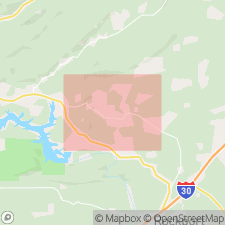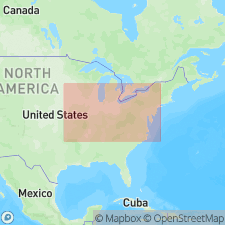
- Usage in publication:
-
- Magnet Cove alkalic igneous complex*
- Modifications:
-
- First used
- Dominant lithology:
-
- Andesite
- Syenite
- AAPG geologic province:
-
- Ouachita folded belt
Summary:
First? published use as a name. Intent to name and designation of a type not stated. Occurs (geologic map) as an elliptically shaped ring dike complex with a central core of mineralogic varieties of ijolite and carbonatite surrounded by fine grained rocks of phonolitic composition, and an outside ring of topographic ridges of feldspathic syenite. Covers an area of about 4.6 sq mi in T 3 S, Rs 17 and 18 W, Hot Spring Co., AR in the Ouachita tectonic folded belt province. Area lies northwest of town of Malvern, north of the Ouachita River, and east of Lake Catherine. Name derived from place called Magnet Cove. Igneous rocks that make up the complex include andesite, various types of pegmatite, aplite, trachyte porphyry, trachyte, tinguaite, and lamprophyre. Quartz-brookite-rutile veins are concentrated in the recrystallized novaculite of the contact zone. Feldspar-carbonatite veins concentrated in the northern two-thirds of the complex. Quartz veins are closely associated with the carbonatite. Feldspar, apatite, and molybdenite veins present within and outside the complex. Intruded sedimentary rocks that range in age from Ordovician to Mississippian. The Paleozoic rocks were altered by the intrusive mass for distances up to 2,500 ft from the contact. Maximum age possible is Mississippian because the youngest unit intruded was Stanley shale. Regional evidence suggests Mesozoic age. Cretaceous? age assigned.
Source: GNU records (USGS DDS-6; Denver GNULEX).

- Usage in publication:
-
- Magnet Cove alkalic igneous complex*
- Modifications:
-
- Geochronologic dating
- AAPG geologic province:
-
- Ouachita folded belt
Summary:
Samples obtained from the alkalic igneous complex at Magnet Cove, Hot Springs Co., AR in the Ouachita tectonic folded belt province. Biotite from sample of melteigite yielded a K-Ar age of 95 m.y. Biotite from sample of garnet ijolite yielded a K-Ar age of 97 m.y. and a Rb-Sr age of 99 m.y., giving an average age of Late Cretaceous.
Source: GNU records (USGS DDS-6; Denver GNULEX).
For more information, please contact Nancy Stamm, Geologic Names Committee Secretary.
Asterisk (*) indicates published by U.S. Geological Survey authors.
"No current usage" (†) implies that a name has been abandoned or has fallen into disuse. Former usage and, if known, replacement name given in parentheses ( ).
Slash (/) indicates name conflicts with nomenclatural guidelines (CSN, 1933; ACSN, 1961, 1970; NACSN, 1983, 2005, 2021). May be explained within brackets ([ ]).

